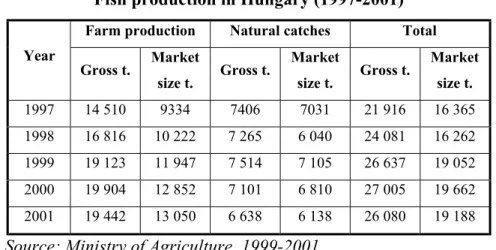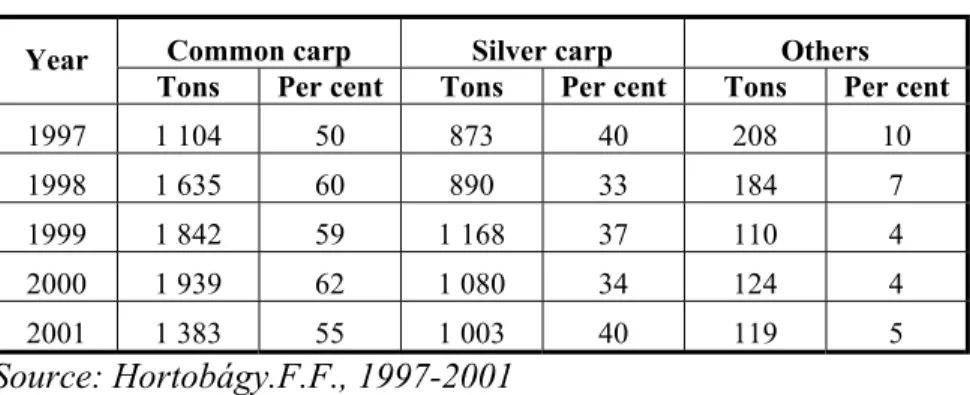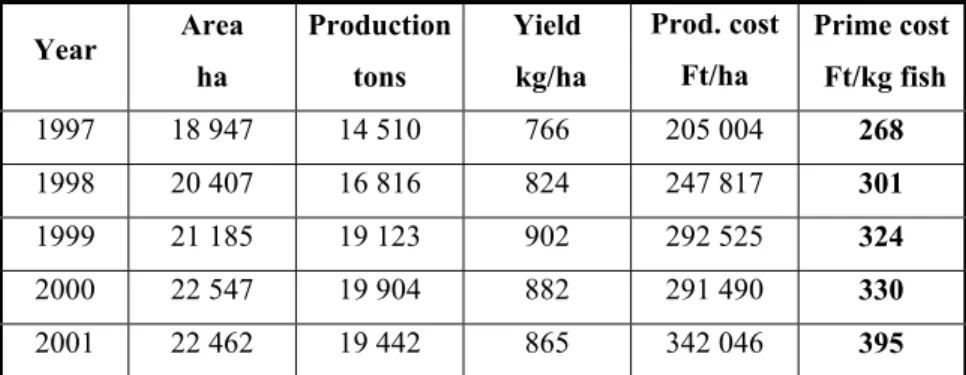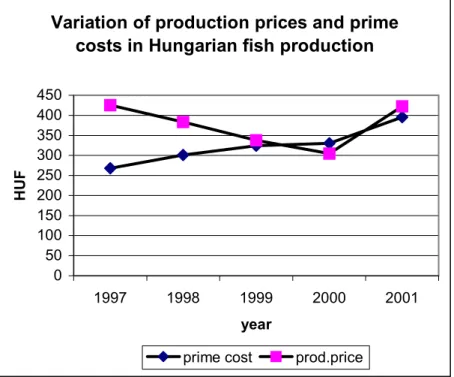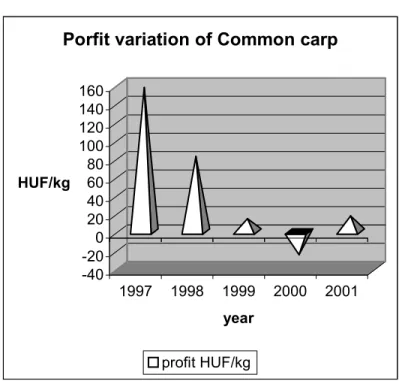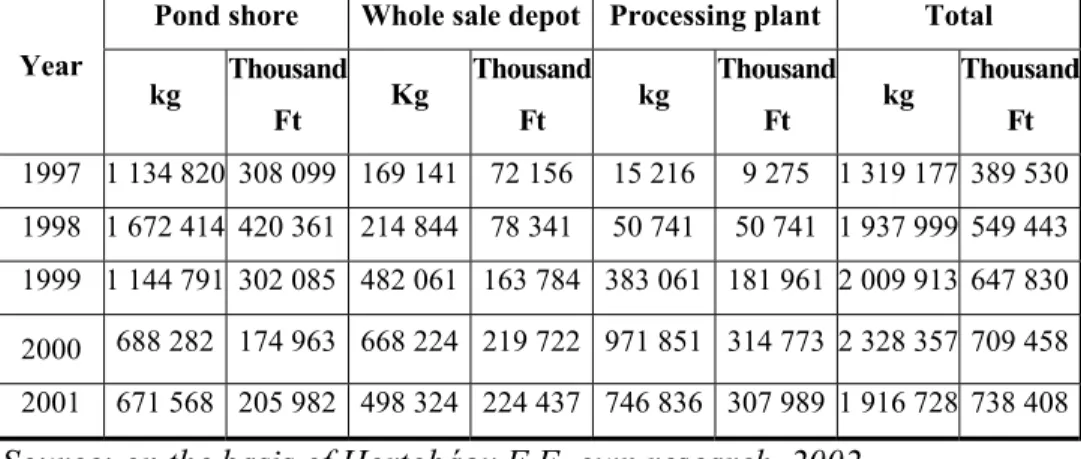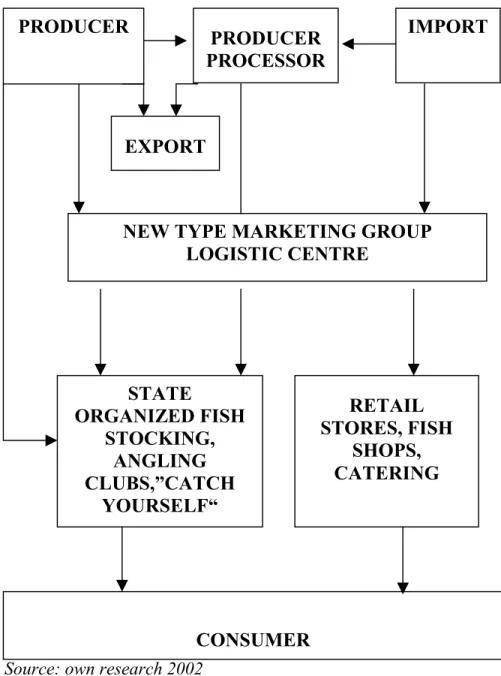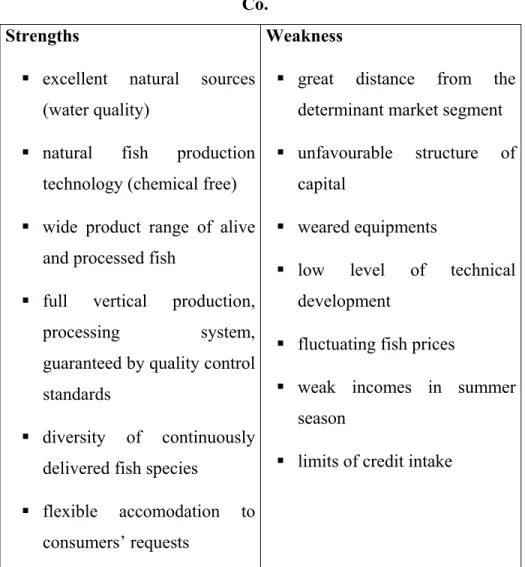THESISES OF PhD DISSERTATION UNIVERSYTY OF WEST HUNGARY
MOSONMAGYARÓVÁR
AGRICULTURE- AND FOOD SCIENCES FACULTY AGRICULRURAL ECONOMICS AND MARKETING
INSTITUTE
Programme leader: Consultant:
DR. SCHMIDT JÁNOS DR. TENK ANTAL
Professor Professor
associate member of candidate of
Hungarian Academy of Sciences agricultural sciences
ECONOMICAL ANALYSIS OF HUNGARIAN FISHERIES SECTOR ON THE EXAMPLE OF
HORTOBÁGY FISH FARM Co.
Prepared by
SZATHMÁRI LÁSZLÓ
MOSONMAGYARÓVÁR 2003
CONTENTS
INTRODUCTION... 3
1. MATERIALS AND METHODS... 6
2. RESEARCH RESULTS ... 9
3. NEW RESULTS OF THE RESEARCH... 23
4. PRACTICAL ADVISES TO UTILIZE THE RESULTS IN FIELD WORK... 25
5. PUBLISHED WORKS OF THE AUTHOR CONCERNING THE THEME ... 27
INTRODUCTION
Fishing and fish conserving are equal in age with the human history. At the begining consume of fish was common in the regions of seaside, and natural inland waters. Later the demand for fish began to occure also among people in territories more distant from waters.
The fish production of the world in the last three decades had increased by 3% per year overtaking the sheep and cattle, but understaying the pork and poultry production.
The woldwide consumption of fish products (fish, mollusc, shrimp) reached the value of 14 kg/capita/year. The decrease of volume of marine catches were followed by the increased production of aquaculture.
The consume of fish and its products has old traditions in Europe, mainly in the seaside countries. The present fish consumption of EU countries is 24 kg/capita/year.
In the Middle-East Europe natural conditions made it possible to establish artificial fish farms producing mainly common carp. These plants supplied fish (mainly carp) according to the seasonal requests of the regions. The fish consumption was related to religious festivals and customs.
Despite of the fact that Hungarian fish farming looks back to a tradition of 150 years, the recorded fresh water fish consumption in Hungary has reached the value of 1,74 kg/capita/year (12% of the world average) only in the recent years.
In the begining of 90’s the fisheries sector participated also in the accession procedure to the EU. The liberalization of import, the increase of the product sortiment creates new challenges to fisheries sector, which shows a relatively small output within the Hungarian animal husbandry.
Today fisheries produce 26 000 tons of fish, which is only 1% of the production value of Hungarian agriculture. Due to the fact that the Hungarian agrarian economy has to be conform to the European political and economical conditions, the fresh water fish processing also has to follow the EU standards, considering consumers’ habits. All of these activities has to be made comply with the strict EU rules in the field of nature and enviroment protection.
The targets of this thesis are the following:
1. Investigation of natural parameters, costs, prices and profitability, market possibilities and fish consumption of Hungarian freshwater fish production.
2. Analysis of the production, costs, prices and profitability data of the Hortobágy Fish Farm Co.
3. Examination of the structure of the present and perspective distribution channels of fish products, as well as the proper elements of marketing strategies suitable for the fisheries sector.
4. Elaboration of the parts of proper marketing srtategy.
In order to deduct conclusions, the collected data were analized by the methods of statistics. On the basis of conclusions the thesis formulates recommendations in the field of production, processing, commerce, and the alternative utilization of fish farm, as well as the logistics and
marketing. The evaluation of a marketing strategy derivated from the literature and the own research, is evaluated by a SWOT analysis.
On the basis of new research results the thesis offers practical possibilities to the fish farms which may be essential after the accession to the European Union
1. MATERIALS AND METHODS
The research of the condition of Hungarian fish farms is based on the elaboration of national and international literature, the 25 years field and foreign missions experiences of the author. The survey was executed between 1997 and 2001.
The national data concerning production and economics were collected from the annual reports of Wild and Fish Department of the Ministry of Agriculture, Agrarian Economical Research and Information Insitute, Fish Product Council and the Association of Hungarian Fish Farmers.
National data were compared with the indexes of production, yields,costs, prices and sales of the Hortobágy Fish Farm Co. It was permitted to use company data, but in case of further process the agreement of the company is needed.
The data about consumer prices were collected from „Halászat”
periodical, and by personal survey. The production prices were collected from the database of Fish Product Council and by own research of the author.
This thesis investigates the production, commercial and profit data of the most widely produced Cyprinids such as Common carp (Cyprinus carpio) and the hybrid of Silver carp (Hipophthalmichtis molitrix) and bighead carp (Hipophthalmichtis nobilis). 90% of the pond production is given by these species.
The collected data were analized by the methods of statistics using MS Excel spreadshet, chart, and function editor softwares.
On the basis of comparsion of statistical lines it is possible to create tables, and with the analysis of ratios conclusions can be deducted. (Roth - Sugár, 1992) The author used these numbers (intensital and comparsion) to analize the production, natural cost, price and income data suitable for the examinations of research hypothesis.
The quantitative variables of production price and costs were processed by arithmetic weighted mean calculations. This method gives more exact result than the simple atrithmetic means.
The most frequent value of the statistical line is the mode. This is a location of central tendency, the other data congregate around it. The mode expresses the nature of variables better than the median or the arithmetic mean. (Manzel, 1983)
The difference of the variables is the variability, which is expressed by a measure called standard deviation (σ). This is the average of quadratic differences derived from the main mean. (Roth - Sugár, 1992)
The values of mode and standard deviation were applicated during the investigations of consumer prices, because according to the author, these data can be evaluated using the above mentioned statistical functions.
The examination between variables, and principles, as well as numeric characterization of the rules of ecomomy are the main tasks of statistics.
The correlation analysis is a special method to investigate correspondences. (Manzel, 1983)
The aim of the correlation analysis is to convert the observed correspondences into numeric forms, in order to make the evaluation possible. The deducted relation is the signed (-1±1) correlation coefficient which shows the significance of the stochastic relation.
(Kröpfl – Peschek – Schneider – Schönlieb, 2000)
The characters of correlation relations according to Svab (1987) are the following: slack below 0.4; moderate from 0.4 to 0.7; strong from 0.7 to 0.9; very strong above 0.9.
The calculation of direct productivity measures were executed using the methods publicated by Nemessályi (2000) The investigations were extended to prime cost, profit rate and the profit level.
During the elaboration of marketing strategy the author compared the methods of elaborated literatures with his own experiences obtained during a marketing and PR course in the USA.
On the basis of literature referring to aquaculture and the own experiences, the author executes a SWOT analysis in order to evaluate the perspective marketing strategy of the Hortobágy Fish Farm Co.
2. RESEARCH RESULTS
The natural conditions of Hungary, the existing fish pond systems and the consumers habits in the last century stimulated the production of cyprinids. By the end of the 90’s national production reached 27 000 tons (Table 1).
Table 1 Fish production in Hungary (1997-2001)
Farm production Natural catches Total Year
Gross t. Market
size t. Gross t. Market
size t. Gross t. Market size t.
1997 14 510 9334 7406 7031 21 916 16 365 1998 16 816 10 222 7 265 6 040 24 081 16 262 1999 19 123 11 947 7 514 7 105 26 637 19 052 2000 19 904 12 852 7 101 6 810 27 005 19 662 2001 19 442 13 050 6 638 6 138 26 080 19 188
Source: Ministry of Agriculture, 1999-2001
The main part of fresh water production takes place at the fish farms. In the last five years the rate of farm production increased from 64% to 74%. During the survey period until 2000, the volume of production increased continuously. In 2001 due to the production conditions as well the low prices, there was a decrease in the volume of production.
The structure of market-size fish production is shown on Tables 2 and 3.
Table 2 National production
Common carp Silver carp Others Year
Tons Per cent Tons Per cent Tons Per cent
1997 6 420 69 2 286 24 628 7
1998 7 069 69 2 247 22 906 9
1999 8 158 68 2 347 20 1 442 12
2000 8 656 67 2 575 20 1 621 13
2001 8 225 63 2 996 23 1 829 14
Source: Ministry of Agriculture, 1997-2001
Table 3 Hortobágy Fish Farm production
Common carp Silver carp Others
Year
Tons Per cent Tons Per cent Tons Per cent
1997 1 104 50 873 40 208 10
1998 1 635 60 890 33 184 7
1999 1 842 59 1 168 37 110 4
2000 1 939 62 1 080 34 124 4
2001 1 383 55 1 003 40 119 5
Source: Hortobágy.F.F., 1997-2001
The yield of fish production consist of natural and feeding yields. The rate of these two yields determines the requirement of materials as well as the prime cost of fish. Against to national average of natural yield rate 32.80%, the value at the Hortobágy F.F. is 46.60%. This results 0.5 kg less stach-value use for 1 kg growth of body weight, in comparsion with the national value.
Changes in domestic market conditions resulted an increase in fish consumption. In 2001 the registrated value reached 3.12 kg/capita/year,
which is 4.5% of the total meat consumption. The fish consumption in the EU countries is 24 kg/capita/year.
The national and the Hortobágy Fish.F. cost structures are demonstrated on Figure 1.
Figure 1
0% 20% 40% 60% 80% 100%
National Hortobágy
Cost structures
material services labour amort. others
Source: Fish Production Council, Hortobágy F.F., 1997-2001
The presentation shows, the differences between national and farm values. At the Hortobágy F.F. the costs of materials are lower, resulted by the decreased artificial food input, while labours costs are relatively high, due to the employment policy of the owner. The cost of water supply is 3-4 times higher at Hortobágy compared to other regions. The reason of more service costs are derived from the operation of fish processing unit and transport costs.
The prime costs of pond production can be seen on Table 4.
Table 4 Prime costs of Hungarian pond fish production (1997-2001)
Year Area ha
Production tons
Yield kg/ha
Prod. cost Ft/ha
Prime cost Ft/kg fish 1997 18 947 14 510 766 205 004 268 1998 20 407 16 816 824 247 817 301 1999 21 185 19 123 902 292 525 324 2000 22 547 19 904 882 291 490 330 2001 22 462 19 442 865 342 046 395
Source: on the basis of Fish Product Council, own research, 2002 Variation of prime cost at the Hortobágy Fish Farm Co.:
1997 1998 1999 2000 2001 236 Ft/kg 271 Ft/kg 303 Ft/kg 334 Ft/kg 376 Ft/kg
The production prices during the survey period are demonstrated on Figure 2.
Figure 2
Production prices of Common and Silver carp
0 100 200 300 400 500
1997 1998 1999 2000 2001
year
HUF/kg
C.carp national S carp national C.carp Hortobágy S Ccarp Hortobágy
Source: Fish Prod. Council Hortobágy F.F., 1997-2001
The relationship between the production prices and prime costs can be seen on Figure 3.
Figure 3 Variation of production prices and prime
costs in Hungarian fish production
0 50 100 150 200 250 300 350 400 450
1997 1998 1999 2000 2001
year
HUF
prime cost prod.price
Source:Fish product Council 1997-2001
Analysing the figure above, it can be stated, that the correlation relationship between production prices and production is negative, strong (-0.713), between the producton and consumer prices is positive, very strong (0.946), while between the production and prime cost is negative, very strong (-0.975).
The latter value indicates the incerase of losses during the main part of the survey period.
Figure 4 presents the variation of profit for 1 kg Common carp.
Figure 4
-40 -20 0 20 40 60 80 100 120 140 160
HUF/kg
1997 1998 1999 2000 2001 year
Porfit variation of Common carp
profit HUF/kg
Source:On the basis of Fish P.C. own calculation 2002
In the Hungarian fisheries sector the profit rates and profit levels show the following values:
profit rate (Common carp) 11.42 % (min. –8.20% max. 6.94%) profit level 12.88% (min. –7.57% max. 58.58%) profit rate (Siver carp ) 11.19% (min. 2.82% max. 7.14%) profit level 12.53% (min. 2.89% max. 20.69%)
The profit measures of the Hortobágy Fish Farm were calculated using the same methods. The values compared with the national measures are more immoderate.
The values are the following:
profit rate (Commom carp) 12.71% (min. –10.23% max. 45.93%) profit level 14.55% (min. –9.28% max. 84.95%) profit rate (Silver carp) 14.59% (min. –0.65% max. 19.01%) profit level 17.09% ( min. –0.64% max. 23.48%)
The following model demonstrates the calculations of profit rates in the case of various Common/Silver carp rates in the production structure.
Table 5 Turnover, costs and profit at diferent Common/Silver carp rates
in the production structure (national)
C/S carp rate Turnover Ft/ha Cost Ft/ha Profit Ft/ha
65/24% 230 208 203 964 26 244
70/19% 240 615 213 195 27 420
75/14% 250 523 221 984 28 539
Source: on the basis of Fish Product Council, own research, 2002 Table 6 Turnover, costs and profit at diferent common/Silver carp rates
in the production structure (Hortobágy F.F.)
C/S carp rate Turnover Ft/ha Cost Ft/ha Profit Ft/ha
65/24% 199 008 173 438 25 570
70/19% 205 758 179 466 26 292
75/14% 215 302 187 876 27 426
Source: on the basis of Hortobágy F.F., own research, 2002
The results show, that the increase of Common carp rate stimulates the absolute increase of turnover costs and profit. At a rate of 75% of Common carp, the turnover increased by 8.82%, costs showed an
increase of 8.82%, while profit went up by 8.74%. The profit rate in the three groups shows the asme value, due to the fact that the profit rates were similar in the case of the two species (Common carp 11.42%, Silver carp 11.19%).
The increase of the turnover results better distribution in constant costs.
According to practical experiences of the author, the optimal rate of Common/Silver carp is 70:30%. In this stucture yield, turnover and profit values are favourable, while domestic and export requirements of Silver carp are ensured.
The investigation of the commercial data of Hortobágy Fish Farm Co.
shows that the sales of processed fish products increases dinamically (Table 7).
Table 7 Market channels of Hortobágy Fish Farm (1997-2001)
Pond shore Whole sale depot Processing plant Total Year
kg Thousand
Ft Kg Thousand
Ft kg Thousand
Ft kg Thousand Ft 1997 1 134 820 308 099 169 141 72 156 15 216 9 275 1 319 177 389 530 1998 1 672 414 420 361 214 844 78 341 50 741 50 741 1 937 999 549 443 1999 1 144 791 302 085 482 061 163 784 383 061 181 961 2 009 913 647 830 2000 688 282 174 963 668 224 219 722 971 851 314 773 2 328 357 709 458 2001 671 568 205 982 498 324 224 437 746 836 307 989 1 916 728 738 408
Source: on the basis of Hortobágy F.F, own research, 2002
The processed fish products can be sold mainly in the department store chains. The variation of sales to this market segment is shown on Table 8.
Table 8 Fish sales of Hortobágy Fish Farm Co. with six retail chains
Year Quantity
kg
Turnover thousand Ft
Turnover increase per cent
1998 40 700 24 261 100
1999 401 052 179 762 740
2000 795 325 308 614 1 272
2001 708 557 332 036 1 368
Source: on the basis of Hortobágy F.F., own research, 2002 The share of sales of the company realized with chains in 2001 reached 45% of the total turnover.
In the last few years the stucture of national fish commerce has changed.
Most of the producers began to sell fish themselves avoiding wholesale commerce. The sales of processed fish belongs to the products range of the sector. Some firms deliver 20-40% of their own production in this form. In the case of Hortobágy Fish Farm Co. the 2001 value was 42%.
After the accession to the EU as a result of forming new type selling organizations, the role of logistic centers will incerase. They will store, handle and distribute alive, fresh and frozen freshwater fish products.
According to the results of the survey, the author elaborated the following model of fish commerce after the accession to the EU. The model is shown on Figure 5.
Figure 5 The model of sales channels of Hungarian Aquaculture after the
accession to EU
Source: own research 2002 PRODUCER
PRODUCER PROCESSOR
IMPORT
EXPORT
NEW TYPE MARKETING GROUP LOGISTIC CENTRE
STATE
ORGANIZED FISH STOCKING,
ANGLING CLUBS,”CATCH
YOURSELF“
RETAIL STORES, FISH
SHOPS, CATERING
CONSUMER
The estimated production volumes, as well as the growing requirements for live and processed fish prognosticates boom for the period of 2003- 2005. This favourable situation can be succesfully utilized by adequate cost planning and proper marketing policy.
After the accession to the EU the food industrty will meet stronger competition, therefore the marketing activities has to be converted to the modified situation. According to the opinion of author, the marketing surveys have to follow the 6 P marketing-mix system, such as :
- product, - price,
- place, - promotion,
- production, - publicity In the fisheries sector, the popularization of the nature protection based fish production, as well as the PR activities take important role in the formation of long term marketing strategies.
The SWOT analysis of the marketing strategy of the company can be seen on Table 9.
9. table SWOT analysis of the marketing strategy of Hortobágy Fish Farm
Co.
Strengths
excellent natural sources (water quality)
natural fish production technology (chemical free) wide product range of alive and processed fish
full vertical production,
processing system, guaranteed by quality control
standards
diversity of continuously delivered fish species
flexible accomodation to consumers’ requests
Weakness
great distance from the determinant market segment unfavourable structure of capital
weared equipments
low level of technical development
fluctuating fish prices
weak incomes in summer season
limits of credit intake
Opportunities
estabilishment of logistic centre contolled by sales group
export of alive, and processed fish to EU contries PR activities, logo policy production and process of bio-fish
stocking of Tisza lake by native fish species
multifunctional operation using the possibilities of angling and ecotourism
product develonment in fish processing
Threats
restricting nature protection rules
intensification of domestic and Middle Europen competition
fish consumption increases slowly due to consumer habits
sales value added fish produts shows very low interest
cheap pork and poultry meat products
Source: Own research, 2002
3. NEW RESULTS OF THE RESEARCH
1. The main part of national carp dominated fish production is performed by the fish farms, and this present rate of 74% will increase after the accession to EU. The modern product structure supposes a higher rate (70%) of Common carp. The incomes , profits and market demand prognosticates more optimal this rate.
2. The research of national fish production, consumer and production prices, as well as the prime costs, resulted to create the following correlation relations:
- production price – market-size fish production r = -0.713 - production price – consumer price r= +0.946 - production price – prime cost r= -0.975
The above mentioned values indicate the considerable market sensitivity of the Hungarian fisheries sector.
3. The detailed statistical analysis of the consumers prices has also given some new research results. The calculation of mode and the standard deviation gives more characteristic scene about the prices, than the simple arithmetic mean. As a result of the survey of consumers prices in the different regions, it can be state, that in Southern Hungary fish prices are lower, than in the northern regions. The difference is 10%/40% in the cases of Common and Silver carps. The explication of the occurence is that in the Southern regions the producers have limited stroring facilities so they sell the harvested fish under national prices. The other reason is the higher fish consumption of the region,
where the great number of small fish shops cause a price decreasing effect. It has to be taken into consideration that after the accession to the EU, the fish commerce will produce more equilibred prices in the country.
4. The results derivated from investigation of the fish product course justify the fact that after the accession the role of intermediate fish commerce will decrease. The producers will establish own sales and logistical centers in order to supply the fish directly to the retail stores and other consumers. The role of retail chain stores is and perspectively will remain determinant in the fish sales. On the basis of the research of sales channels of fish, the author formed the modell of national fish product course for the period of membership in EU countries.
5. It can be deducted as a new result that during the elaboration of marketing strategy it is advisable to use the 6P marketing-mix method.
The author regards as a new result the SWOT analysis of the marketing strategy of Hortobágy Fish Farm Co.
4. PRACTICAL ADVISES TO UTILIZE THE RESULTS IN FIELD WORK
1. The fish farm in Hungary should ensure a minimum rate of 70% of Common carp in the product structure with a size of 1.5-2.0 kg/pce.
2. It is recommended to execute a reform in the cost structure of the Hortobágy Fish Farm Co. in order to decrease the labour costs. It is highly advisable to begin the programme of Hortobágy bio-fish production.
3. The farms ought to create angling facilities connected with other spare time activities. The ponds which can be used only for extensive production, should be stocked with fingerling of carnivorous fish species, which are very well sold in the EU countries.
4. Those firms operating fish processing plants, should execute product developing in order to create value added fish products. Boneless fillets, pastes, fish sausages and smoked slices of Cyprinids are suitable for this purpose. It is advised to process and sell imported fishes in summer (grill) season such as trout and Nile perch.
5. The application rules for EU supports and the competition of retail chains will make it necessary to establish processing and sales groups, as well as logistic centres to store, handle and distribute alive, fresh and frozen fish products, applicating updated communications systems.
6. It is recommended to settle a programme, which focuses on the advantages of fish consumption from the health preserving point of view.
7. It is advisable to create an updated informational database system to provide the producers production, veterinarian and market related information.
5. PUBLISHED WORKS OF THE AUTHOR CONCERNING THE THEME
Publications in Hungarian language in revised periodicals:
Szathmári, L. – Tenk, A. (2001): Haltermelés és értékesítés Magyarországon, Gazdálkodás, 2001. 6. sz. 35-43. o., Gyöngyös, 2001.
Szathmári,L-Tenk A. (2002): Édesvízi haltermelés jövedelmezőségének vizsgálata Gazdálkodás, (megjelenés alatt ).
A Szathmári,L-Tenk, (2003): A tógazdasági haltermelés ár és költségelemzése Halászat, (megjelenés alatt).
Passage in revised book in Hungarian language:
Ulviczkiné, H. J – Szathmári, L. – Sztanó, J. (2001) Gazdálkodási és szervezési ismeretek – halász- 3-5, 55-68,105-112 o. Agrárszakoktatási Intézet Budapest, 2001.
Revised publications in foreign languages:
Szathmári, L. – Figueiroa, N. (1989): Beneficiamento e conservacao de alguns peixes cultivados em água doce, CODEVASF, Brasília/DF, 1989.
Szathmári, L. (1992): Manual de beneficiamento dos pescados e crustaceos de água doce, DNOCS, Fortaléza/CE, 1992.
Szathmári, L.-Tenk, A. (2001) Fish Production and Marketing in Hungary, Gazdálkodás, 2001. 3. sz különkiadás, 59-67 o., Gyöngyös, 2001.
Publications in Hungarian language:
Szathmári, L. (2001): Marketing stratégia a feldolgozott haltermékekre, TEHAG Kft. Kézirat, Százhalombatta, 2001.
Szathmári, L. – Tenk, A. (2002): Édesvízi halak termelése, forgalmazása és jövedelmezősége Magyarországon, Óvári Tudományos Napok kézirat, 76. o. Mosonmagyaróvár 2002.
Publications in foreign language:
Szathmári, L. – Tenk A. (2002): Fresh Water Fish Production, Commerce and Profitability in Hungary, HAKI, Szarvas, 2002.
